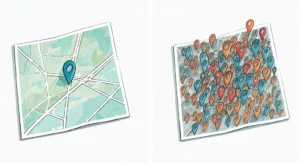How to Adapt Your SEO Strategy for Zero-Click Searches
Zero-click searches are flipping the SEO world upside down. With more users getting instant answers straight from the search results page (without the courtesy of visiting your website, of course), old-school SEO strategies need to catch up. This shift is shaking up how businesses handle their online presence and keep their visibility game strong.
In this article, we’ll dive into the wild world of zero-click searches, how they’re messing with your metrics, and what you can do to survive. Spoiler: It’s not all doom and gloom. With a few tweaks, you can stay in the spotlight and still grab some attention in the ever-evolving search game.
Understanding Zero-Click Searches
Definition and Types of Zero-Click Searches
Zero-click searches are like that friend who gets everything they need without ever stepping into a store. These searches give users answers directly on the search engine results page (SERP), no click required. It’s all about fast, easy answers, and let’s face it—search engines are spoiling users rotten.
Here’s the lineup of zero-click search types:
- Instant Answers: Quick fixes for things like “What’s 7 times 8?” or “How do you spell ‘bureaucracy’?”—the kind of stuff that stops you from embarrassing yourself at a dinner party.
- Knowledge Panels: These sit smugly on the right, showcasing everything you need to know about a person, place, or thing. Think of it as the Wikipedia of SERPs.
- Featured Snippets: Known as “Position Zero,” these snippets leapfrog over everything else, flaunting their answers in lists or step-by-step guides.
- Direct Answer Boxes: Because sometimes, you just need the answer without a story. Perfect for quick math, weather, or dictionary definitions.
- Local Packs: Handy little maps and business listings for when you’re lost, hungry, or both.
Rise of Voice Search and Mobile Queries
Blame it on Siri, Alexa, and their friends—voice search is skyrocketing. People love shouting questions at their devices and getting instant answers, so why bother typing? And mobile users? They’re the kings of quick searches. In fact, a whopping 77.2% of mobile searches never result in a click. (Yes, they’ve perfected the art of searching without searching.)
Impact on Traditional SEO Metrics
Decrease in Organic Click-Through Rates
Remember when people used to click on your site for answers? Good times. Now, thanks to zero-click searches, that’s happening less and less. Back in 2020, a jaw-dropping 64.82% of Google searches didn’t result in a single click. It’s like standing at your lemonade stand, but everyone’s already got lemonade in their hands.
Desktop and mobile searches are equally guilty. About 25% of desktop searches and 17% of mobile searches serve up the goods without anyone ever visiting your precious website. Ouch.
Shift in Focus: From Traffic to Visibility
It’s time to stop obsessing over click-through rates (CTR) and start paying attention to visibility. Think of SEO visibility as your new favorite metric. It measures how much of the search engine real estate you own, even if users don’t knock on your door.
New KPIs for Measuring Success
Forget your old KPIs—they’re like flip phones in the age of smartphones. Here’s what you should be tracking now:
- Impressions: The number of times your site almost gets clicked.
- Search Position: Where you’re ranking, even if no one’s clicking.
- SERP Feature Visibility: Are you showing up in cool spots like snippets or knowledge panels? If not, it’s time to get with the program.
- Engagement Metrics: For the clicks you do get, check out bounce rates and time on page. Quality over quantity, right?
- Local Search Metrics: For local businesses, tracking how often you show up in Google My Business searches is key.
Optimizing Content for Zero-Click Results
If you want to thrive in a zero-click world, you’ve got to cater to these instant-gratification searchers. That means making your content snackable and direct.
Structured Data and Schema Markup
Think of schema markup like adding neon signs to your content so search engines can pick you out of the crowd. It’s the secret sauce that helps you land those flashy featured snippets.
Creating Concise, Direct Answers
Stop beating around the bush—give the people what they want! Structure your content to answer questions quickly, with just enough info to keep them curious. Aim for short and sweet, around 40-50 words.
Leverage FAQ Pages and Question-Based Content
Everyone loves an FAQ, especially search engines. Set up dedicated FAQ sections that are packed with long-tail keywords and common user questions. Pro tip: Use FAQ schema markup to help search engines pick up on your content and display it in all its zero-click glory.
Conclusion
Zero-click searches are here to stay, so you might as well make the most of them. Sure, it means fewer clicks, but it also means new opportunities to boost your visibility and flex your expertise. Embrace the shift, adapt your SEO strategy, and you’ll still find yourself in the spotlight, even if no one’s clicking.


